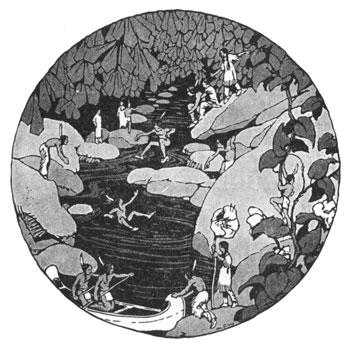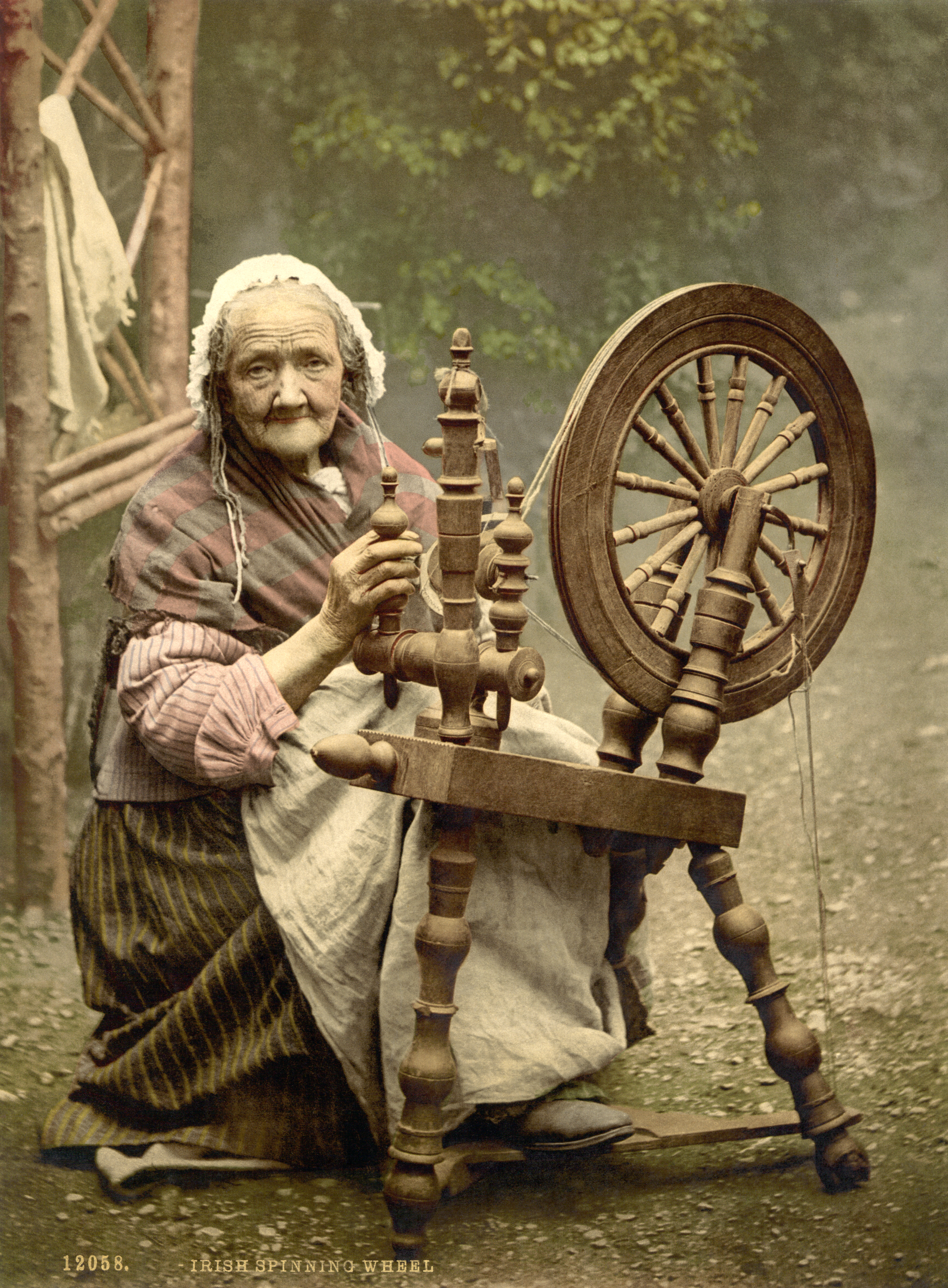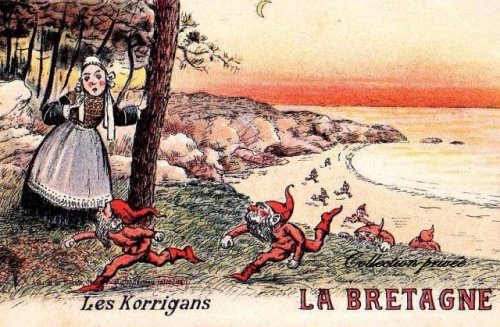|
Fions
Fions are lutin-like creatures of the little people, mostly mentioned in the maritime folklore of Upper Brittany. They might be of English origin. Most of the stories about them come from Paul Sébillot's collections in the late 19th century. Characterized by their habitat in the rocks and caves of Brittany's northern shores, the Fions lead a military life in community with the ''houles'' fairies, as their servants. Organized into battalions, they are said to wage war on a golden ship. According to tales, they own and graze livestock, and sometimes give enchanted objects or food to humans. Pierre Dubois and Joann Sfar featured a Fion in the comic strip series '' Petrus Barbygère'', in 1996 and 1997. Terminology, origin and gender The origin of the name "Fions" is not known, and its usage remains unclear. For Walter Evans-Wentz, the term seems to have originally referred to fairies, but it can also apply to little people creatures of both sexes. Opinions differ on this poin ... [...More Info...] [...Related Items...] OR: [Wikipedia] [Google] [Baidu] |
Little People (mythology)
Little people have been part of the folklore of many cultures in human history, including Ireland, Greece, the Philippines, the Hawaiian Islands, New Zealand, Flores Island, Indonesia, and Native Americans. Native American folklore The Native peoples of North America told legends of a race of "little people" who lived in the woods near sandy hills and sometimes near rocks located along large bodies of water, such as the Great Lakes. Often described as "hairy-faced dwarfs" in stories, petroglyph illustrations show them with horns on their head and traveling in a group of 5 to 7 per canoe. Native legends often talk of the little people playing pranks on people, such as singing and then hiding when an inquisitive person searches for the music. It is often said that the little people love children and would take them away from bad or abusive parents or if the child was without parents and left in the woods to fend for themselves. Other legends say the little people if seen by ... [...More Info...] [...Related Items...] OR: [Wikipedia] [Google] [Baidu] |
Hermaphrodite
In reproductive biology, a hermaphrodite () is an organism that has both kinds of reproductive organs and can produce both gametes associated with male and female sexes. Many taxonomic groups of animals (mostly invertebrates) do not have separate sexes. In these groups, hermaphroditism is a normal condition, enabling a form of sexual reproduction in which either partner can act as the female or male. For example, the great majority of tunicates, pulmonate molluscs, opisthobranch, earthworms, and slugs are hermaphrodites. Hermaphroditism is also found in some fish species and to a lesser degree in other vertebrates. Most plants are also hermaphrodites. Animal species having different sexes, male and female, are called gonochoric, which is the opposite of hermaphrodite. There are also species where hermaphrodites exist alongside males (called androdioecy) or alongside females (called gynodioecy), or all three exist in the same species (called trioecy); these three ... [...More Info...] [...Related Items...] OR: [Wikipedia] [Google] [Baidu] |
Dinard
Dinard (; br, Dinarzh, ; Gallo: ''Dinard'') is a commune in the Ille-et-Vilaine department, Brittany, northwestern France. Dinard is on the Côte d'Émeraude of Brittany. Its beaches and mild climate make it a holiday destination, and this has resulted in the town having a variety of famous visitors and residents. The towns of Pleurtuit and Saint-Malo are nearby and the Dinard Pleurtuit Saint-Malo airport is about 4 km south of Dinard. With its international film festival, villas, sumptuous hotels and casino, Dinard is regarded as one of the most prestigious seaside resorts in all of France. History In modern history Dinard was first settled by Saint-Malo's shipping merchants, who built some of the town's larger houses, very few of which survive. In the late 19th century, American and British aristocrats made Dinard a fashionable summer resort, and they built stunning villas on the cliff tops and exclusive hotels such as the 'Le Grand Hotel' on the seafront dur ... [...More Info...] [...Related Items...] OR: [Wikipedia] [Google] [Baidu] |
Rance (river)
The Rance (; br, Renk) is a river of northwestern France. It is long. It flows into the English Channel between Dinard and Saint-Malo. Before reaching the Channel, its waters are barred by a 750 metre long dam forming the Rance tidal power plant. The river is linked to the Vilaine by means of the Canal d'Ille-et-Rance. '' Départements'' and towns along the river: * Côtes-d'Armor: Collinée, Caulnes, Dinan * Ille-et-Vilaine: Dinard, Saint-Malo Hydrology and water quality Tributaries of the Rance include: * Croqueloir * Clergé * Fremeur * Quinéford This river has moderate turbidity and its brownish water is somewhat low in velocity due to the slight gradient of the watercourse; pH levels have been measured at 8.13Hogan, C. Michael, ''Water quality of freshwater bodies in France'', Lumina Press, Aberdeen, Scotland(2006) within the city of Dinan and electrical conductivity Electrical resistivity (also called specific electrical resistance or volume resistivity) is ... [...More Info...] [...Related Items...] OR: [Wikipedia] [Google] [Baidu] |
Pleurtuit
Pleurtuit (; ) is a commune in the Ille-et-Vilaine department of Brittany in northwestern France. Population Inhabitants of Pleurtuit are called in French ''pleurtuisiens''. See also * Dinard - Pleurtuit - Saint-Malo Airport *Communes of the Ille-et-Vilaine department The following is a list of the 333 communes of the Ille-et-Vilaine department of France. The communes cooperate in the following intercommunalities (as of 2020):Official website of Pleurtuit * Mayors of Ille-et-Vilaine Association [...More Info...] [...Related Items...] OR: [Wikipedia] [Google] [Baidu] |
Pleurtuit - Cale De Jouvente 130609-02
Pleurtuit (; ) is a commune in the Ille-et-Vilaine department of Brittany in northwestern France. Population Inhabitants of Pleurtuit are called in French ''pleurtuisiens''. See also * Dinard - Pleurtuit - Saint-Malo Airport *Communes of the Ille-et-Vilaine department The following is a list of the 333 communes of the Ille-et-Vilaine department of France. The communes cooperate in the following intercommunalities (as of 2020):Official website of Pleurtuit * Mayors of Ille-et-Vilaine Association [...More Info...] [...Related Items...] OR: [Wikipedia] [Google] [Baidu] |
Changeling
A changeling, also historically referred to as an auf or oaf, is a human-like creature found in folklore Folklore is shared by a particular group of people; it encompasses the traditions common to that culture, subculture or group. This includes oral traditions such as Narrative, tales, legends, proverbs and jokes. They include material culture, r ... throughout Europe. A changeling was believed to be a fairy that had been left in place of a human (typically a child) stolen by other fairies. Description A changeling is typically identifiable via a number of traits; in Irish legend, a fairy child may appear sickly and will not grow in size like a normal child, and may have notable physical characteristics such as a beard or long teeth. They may also display intelligence far beyond their apparent years, as well as possess uncanny insight. A common way that a changeling could identify itself is through displaying unusual behaviour when it thinks it is alone, such as jumping ... [...More Info...] [...Related Items...] OR: [Wikipedia] [Google] [Baidu] |
Toy Soldier
A toy soldier is a miniature figurine that represents a soldier. The term applies to depictions of uniformed military personnel from all eras, and includes knights, cowboys, American Indians, pirates, samurai, and other subjects that involve combat-related themes. Toy soldiers vary from simple playthings to highly realistic and detailed models. The latter are of more recent development and are sometimes called model figures to distinguish them from traditional toy soldiers. Larger scale toys such as dolls and action figures may come in military uniforms, but they are not generally considered toy soldiers. Toy soldiers are made from all types of material, but the most common mass-produced varieties are metal and plastic. There are many different kinds of toy soldiers, including tin soldiers or ''flats'', hollow-cast metal figures, composition figures, and plastic army men. Metal toy soldiers were traditionally sold in sets; plastic figures were sold in toy shops individu ... [...More Info...] [...Related Items...] OR: [Wikipedia] [Google] [Baidu] |
Spinning Wheel
A spinning wheel is a device for spinning thread or yarn from fibres. It was fundamental to the cotton textile industry prior to the Industrial Revolution. It laid the foundations for later machinery such as the spinning jenny and spinning frame, which displaced the spinning wheel during the Industrial Revolution. Function The basic spinning of yarn involves taking a clump of fibres and teasing a bit of them out, then twisting it into a basic string shape. The spinner continues pulling and twisting to make it longer and longer, and to control the thickness. Thousands of years ago, people began doing this onto a stick, called a spindle, which was a very lengthy process. The actual wheel part of a spinning wheel does not take the place of the spindle, instead it automates the twisting process, allowing one to "twist" the thread without having to constantly do so manually, and also the size of the wheel lets one more finely control the amount of twist. The thread still ends ... [...More Info...] [...Related Items...] OR: [Wikipedia] [Google] [Baidu] |
Saint-Briac-sur-Mer
Saint-Briac-sur-Mer (, literally ''Saint-Briac on Sea''; ; Gallo: ''Saent-Beriac''), is a commune in the Ille-et-Vilaine Department in Brittany in northwestern France. Population Inhabitants of Saint-Briac-sur-Mer are called ''briacins'' in French. Climate St Briac lies on the Gulf Stream which means it enjoys a warm climate, several degrees warmer than the surrounding areas. The village has fine examples of tropical palms and plants, along the streets, making strolls very enjoyable. Leisure Saint Briac has two campsites, seven beaches, four tennis courts, one soccer field, a yacht club, one mini golf, one 18 hole golf course, and more than 5 restaurants. History The name Saint Briac comes from the name of Saint Briag, an Irishman. Briag arrived from Ireland with Saint Tugdual in around 548. On 4 and 5 September 1758, a British fleet of 113 ships under the command of Admiral Richard Howe, landed east of the Garde Guerin, in Saint Briac. With a force of more than 12,00 ... [...More Info...] [...Related Items...] OR: [Wikipedia] [Google] [Baidu] |
Changeling
A changeling, also historically referred to as an auf or oaf, is a human-like creature found in folklore Folklore is shared by a particular group of people; it encompasses the traditions common to that culture, subculture or group. This includes oral traditions such as Narrative, tales, legends, proverbs and jokes. They include material culture, r ... throughout Europe. A changeling was believed to be a fairy that had been left in place of a human (typically a child) stolen by other fairies. Description A changeling is typically identifiable via a number of traits; in Irish legend, a fairy child may appear sickly and will not grow in size like a normal child, and may have notable physical characteristics such as a beard or long teeth. They may also display intelligence far beyond their apparent years, as well as possess uncanny insight. A common way that a changeling could identify itself is through displaying unusual behaviour when it thinks it is alone, such as jumping ... [...More Info...] [...Related Items...] OR: [Wikipedia] [Google] [Baidu] |
Korrigan
In Breton folklore, a Korrigan () is a fairy or dwarf-like spirit. The word ''korrigan'' means in Breton "small-dwarf" (''korr'' means dwarf, ''ig'' is a diminutive and the suffix ''an'' is a hypocoristic). It is closely related to the Cornish word ''korrik'' which means ''gnome''. The name changes according to the place. Among the other names, there are ''korrig'', ''korred'', ''korrs'', ''kores'', ''couril'', ''crion'', ''goric'',Theresa Bane, ''Encyclopedia of Fairies in World Folklore and Mythology'', p205, 2013, McFarland & Company, ''kornandon'', ''ozigan'', ''nozigan'', ''teuz'', ''torrigan'', ''viltañs'', ''poulpikan'', ''poulpiquet'', and ''paotred ar sabad''. As fairies and dwarves The term is used variously by writers on Breton folklore. Théodore de Villemarqué in '' Barzaz Breiz'' uses the term interchangeably with "fairy" and distinguishes them from dwarves ("nains"). In contrast Walter Evans-Wentz in ''The Fairy Faith in Celtic Countries'' argued that in the ... [...More Info...] [...Related Items...] OR: [Wikipedia] [Google] [Baidu] |





